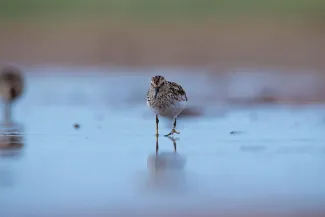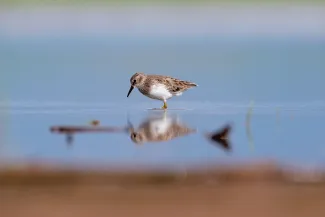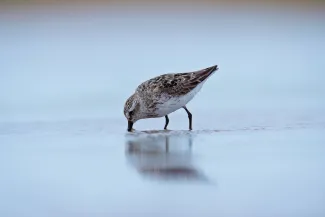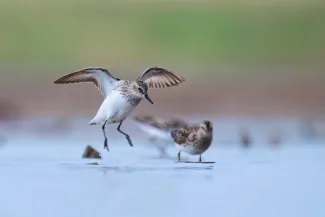Each year, sandpipers and other shorebirds fly more than 2,000 miles from their high-Arctic breeding grounds to their South American wintering grounds. Along the way, they must take short breaks to rest and refuel on small aquatic crustaceans. Hackberry Flat Wildlife Management Area in southwestern Oklahoma is a stopover for many of those sandpipers. Area biologist Kelvin Schoonover recently pointed out a mass of the small shorebirds frantically probing the exposed mud to fellow biologist and photographer Jeremiah Zurenda, who saw an opportunity to combine his love for the outdoors and his passion for photography.

Least Sandpiper
“Oklahoma has a lot of exceptional places to watch – and photograph – nature, and Hackberry Flat WMA is a great example. The flooded wetlands attract a large number of shorebirds and wading birds during the spring and fall migrations. Because of that, it has become a really popular bird watching and wildlife photography spot,” Zurenda said.
After years of honing his skill, Zurenda has learned location is one key to getting high-quality nature photos.
“Spending time in areas with a lot of wildlife and a lot of photo opportunities will significantly increase your chances of success. On this particular day the sheer number of birds on the mudflat meant there were a lot of chances to get a photo I was happy with.”

Least Sandpiper
For most photos, Zurenda says another story can be told from behind the lens.
“When I look at a photo I’ve taken, it pulls me right back to the memory of getting the shot. I can tell you if I was standing knee-deep in water, had to wade through tall grass, or if I ended up with chigger bites after getting the shot I was hoping for.”
For this series of photos, Zurenda remembers the challenge of approaching his subjects without disturbing the flighty birds.
“We were on a lunch break when we first spotted the sandpipers about 300 yards away. I grabbed my camera and face mask to blend in with the landscape and started walking toward the mudflat. When I was 75 yards from the birds, I started crawling on my hands and knees. Forty yards out, I started belly crawling in the mud until I got to the water’s edge. By then, the birds were only about 25 yards away.”

Semipalmated Sandpiper
Zurenda waited in the hot sun as the birds continued feeding closer.
“I laid there long enough sweat was getting in my eyes under the mask I was wearing. But it was worth it. The birds kept coming and some eventually got so close that my camera couldn’t focus on them; they were closer than 7.6 feet!”

Semipalmated Sandpiper
“After a few shots I noticed one of the birds would jump a few inches out of the water when I would hit the shutter release. So I spent some time with the camera focused on that bird. It took a little bit of patience, but I was finally able to time the shot just right.”
Create your own story behind the lens at Hackberry Flat WMA, or one of the many management areas across the state. Licensing requirements and area closures can be found in the Oklahoma Hunting and Fishing Regulations Guide.